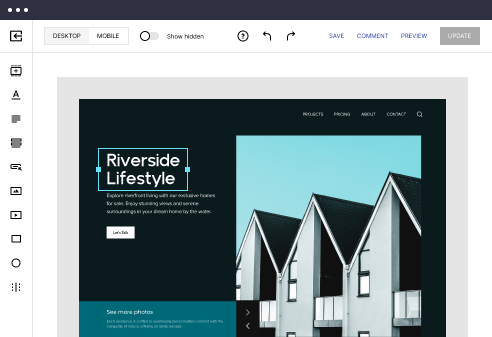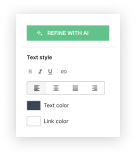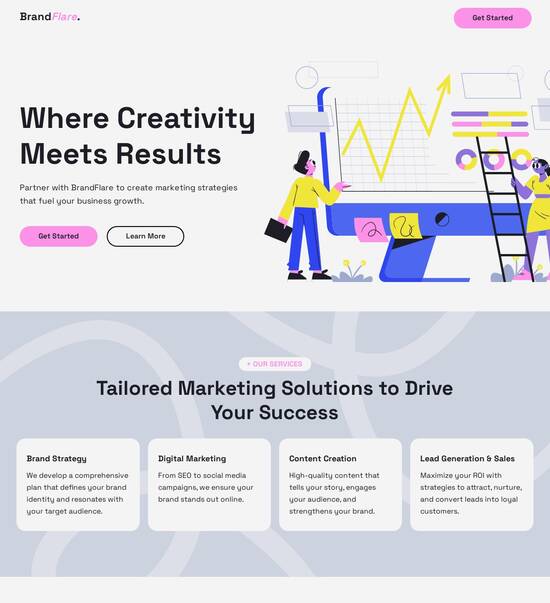
React.js optimized search engine template
Explore Similar TemplatesAbout template
Leverage our intuitive page builder and high-converting React.js optimized search engine template.
Recommended templates
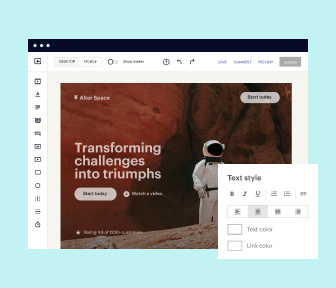
Easy to build without coding
With the intuitive drag-and-drop builder, anyone on your team can create high-converting pages without any knowledge of code or design. Make enhancements to your landing page with custom widgets using Javascript, HTML/CSS, or third-party scripts.
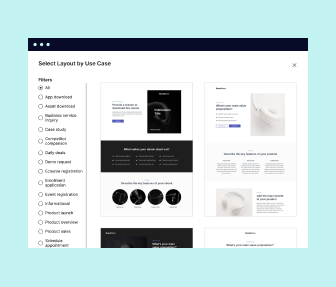
Multiple layouts for any industry and goal
Select from 500+ landing page layouts built to boost conversions across industry-specific scenarios. Customize them by adjusting fonts, adding images, and generating on-brand content with the AI assistant. Quickly scale with Instablocks® and Global Blocks that you can save, reuse, and update globally.
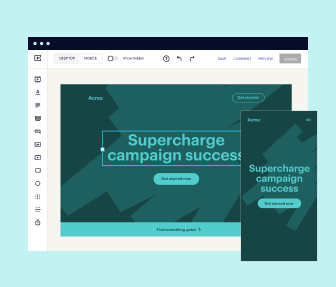
Loads fast and looks polished on any device
Every template is responsive, which means they present professionally on any device and load blazingly fast with our Thor Render Engine. You can also power them up with Google AMP technology to deliver an unparalleled mobile experience and drive higher conversions.
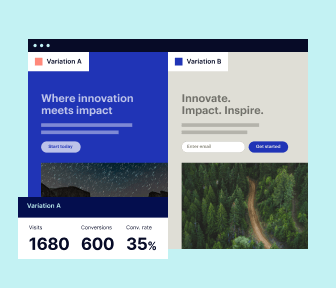
Robust analytics & experimentation
Get real-time updates and reporting across all your devices, showing the number of visitors, conversions, cost-per-visitor, and cost-per-lead. Launch AI-powered experiments, run A/B tests, and use heatmaps to analyze user behavior, then optimize your landing page to maximize conversions.

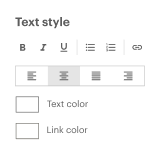
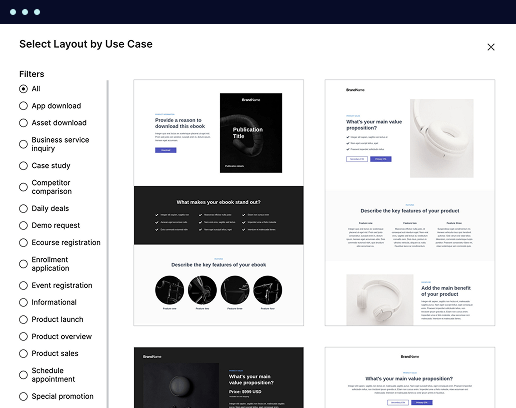
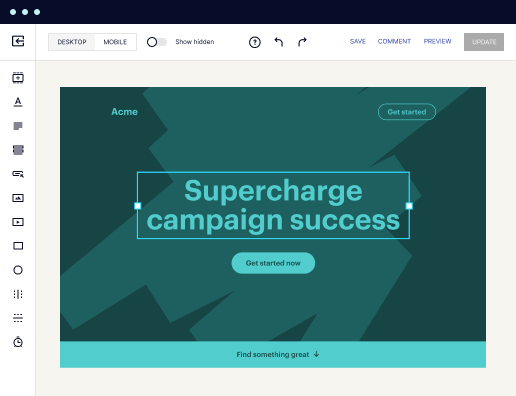

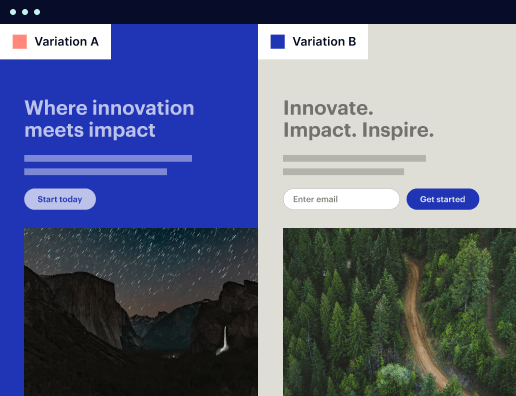

Easy to build without coding
With the intuitive drag-and-drop builder, anyone on your team can create high-converting pages without any knowledge of code or design. Make enhancements to your landing page with custom widgets using Javascript, HTML/CSS, or third-party scripts.
Multiple layouts for any industry and goal
Select from 500+ landing page layouts built to boost conversions across industry-specific scenarios. Customize them by adjusting fonts, adding images, and generating on-brand content with the AI assistant. Quickly scale with Instablocks® and Global Blocks that you can save, reuse, and update globally.
Loads fast and looks polished on any device
Every template is responsive, which means they present professionally on any device and load blazingly fast with our Thor Render Engine.
Robust analytics & experimentation
Get real-time updates and reporting across all your devices, showing the number of visitors, conversions, cost-per-visitor, and cost-per-lead. Launch AI-powered experiments, run A/B tests, and use heatmaps to analyze user behavior, then optimize your landing page to maximize conversions.
All the features you need to build react search engine
Explore more featuresLearn how to build templates for search engine
Frequently asked questions about react search template
Leading the way in building high-performing landing pages





Search engine design templates: Your ultimate how-to guide
Navigating the world of marketing can be overwhelming, especially when it comes to creating landing pages that convert. Instapage offers a robust platform that allows marketers to quickly design, optimize, and personalize landing pages that maximize ROI. In this guide, we'll explore the essential steps for leveraging Instapage to enhance your digital campaigns effectively.
Understanding the basics of Instapage
Instapage stands out in the crowded marketplace of landing page tools due to its comprehensive features and user-friendly interface. Whether you're in business services, tech, or education, Instapage caters to all verticals, making it a go-to solution for marketers in the USA. Its extensive library of over 100 templates ensures that users can create stunning pages without prior coding experience.
- Templates & Lead Gen Elements: Choose from high-converting templates and pre-built lead elements that facilitate immediate lead capture.
- Landing Pages: Easy creation of landing pages with no coding required, focusing on conversion-oriented layouts.
- Optimization Tools: Use built-in features like A/B testing and heatmaps to enhance page performance based on real user interactions.
Step 1: Creating your landing page
To kick off your landing page creation, first select a template that aligns with your campaign goals. Instapage allows easy customization, enabling you to modify layouts and content seamlessly.
- Select a template that represents your brand: Choose one that best fits your target audience's expectations.
- Utilize Instablocks for quick adjustments: Drag and drop components to recreate or tailor your design quickly.
- Incorporate strong calls-to-action: Make sure your CTA buttons are prominent and convey a sense of urgency or value.
Step 2: Optimizing for conversions
Once your landing page is built, optimization is crucial for ensuring high conversion rates. Use the A/B testing feature to compare different versions of your landing page.
- Implement A/B tests: Test variations of headlines, images, and CTAs to understand what resonates best with your audience.
- Monitor heatmap data: Analyze how users interact with your landing page to identify areas for improvement.
- Assess conversion metrics: Use the analytics dashboard to track performance and adjust strategies as necessary.
Step 3: Personalizing the experience
Tailoring content to different audience segments can significantly boost your conversion rates. Use Instapage's personalization features to provide uniquely relevant experiences for visitors.
- Dynamic text replacement: Adapt the landing page's text to match the specific queries or interests of your visitors.
- Audience-specific ads with AdMaps: Align targeted ads to unique landing pages to increase relevance.
- Utilize tracking tools: Monitor how different segments respond to various messaging to further refine your campaigns.
With these steps, Instapage equips marketing professionals across various sectors to create effective landing pages that not only attract but also convert visitors.
Don't miss out on elevating your marketing campaigns using Instapage’s powerful tools. Start with your free trial today and take the first step towards mastering landing page optimization!
People also ask about search engine layouts
Unraveling the Power of ReactJS in Crafting SEO-Optimized Search Engine Templates
The intersection of ReactJS and SEO
In the digital landscape, SEO (Search Engine Optimization) is paramount for ensuring that a website captures attention and ranks well in search engine results. SEO encompasses a series of strategies aimed at boosting a website's visibility, which, in turn, drives traffic and increases conversions. The significance of SEO in digital marketing cannot be overstated; it is the backbone of successful online presence.
Several factors contribute to SEO ranking, including keyword relevance, site speed, mobile-friendliness, and the quality of content. These elements work in harmony to enhance search visibility and authority, making it essential for businesses to adopt a comprehensive approach to their SEO strategies, especially when employing modern frameworks like ReactJS.
ReactJS serves a dual role: it not only aids in building interactive user interfaces, but it can also significantly contribute to SEO performance. When developers understand how ReactJS interacts with SEO principles, they can create templates that effectively optimize search engine visibility.
How ReactJS contributes to SEO
ReactJS applications typically operate as single-page applications (SPAs), where user interactions result in dynamic content loading without reloading the webpage. This approach enhances user experience by providing fluid transitions. However, it raises concerns regarding SEO since traditional search engines have trouble indexing content delivered solely via JavaScript.
To address these challenges, developers can choose between client-side rendering (CSR) and server-side rendering (SSR). CSR takes place on the user's device, loading JavaScript files that build the interface, potentially causing search engines to miss content. Conversely, SSR renders content on the server and delivers fully formed HTML pages to the client, ensuring search engines can easily crawl and index the content.
Key features of ReactJS optimized search engine templates
Engaging users effectively requires a robust understanding of key features that enhance SEO performance in React applications. Server-side rendering (SSR), dynamic rendering techniques, and structured data implementation are among the most critical components every developer should consider while crafting search engine templates.
Server-side rendering (SSR) in React
Server-side rendering (SSR) is a method where a web page's content is generated on the server before being sent to the client. This results in faster initial load times, as the server delivers fully rendered HTML, which enhances SEO performance. Pre-rendering content allows search engine bots to easily index the page, increasing the chances of higher search rankings.
The benefits do not stop there; SSR improves the user experience by reducing load times. When users land on a page with structured content, they can interact without delay, significantly enhancing engagement. For instance, e-commerce platforms often utilize SSR to present product listings and details that are crucial for conversions, ensuring potential customers can access relevant information instantly.
Dynamic rendering techniques
Dynamic rendering is another innovative solution that offers distinct advantages for SEO by serving different content based on whether the visitor is a search engine bot or a human user. This technique allows developers to optimize how content is delivered without compromising user experience.
For example, dynamic rendering can enable developers to serve optimized HTML content to search engine crawlers while providing a more interactive version for regular users through JavaScript. This ensures that search engines can index complete content effectively, addressing one of the major challenges posed by SPAs.
Structured data implementation
Structured data plays a crucial role in enhancing search visibility by helping search engines understand the content and context of a website. By integrating schema markup, developers can effectively communicate important information about a webpage, such as product details, reviews, or event timings.
Best practices involve embedding annotations into React components that define the structured data format clearly, ensuring that search engine crawlers can interpret and display relevant information in rich snippets. This not only improves visibility in search results but can also significantly influence click-through rates.
Enhancing user experience through ReactJS features
An enterprise-level focus on user experience (UX) is intertwined with SEO success. Various ReactJS features can significantly enhance user experience, including optimized page loading times, responsive designs, and effective URL management through React Router.
Fast page loads are essential for maintaining user interest and minimizing bounce rates. When a page loads quickly, users are more likely to stay engaged, leading to improved performance on search engines. Techniques like code splitting and lazy loading can be utilized to create faster React applications by loading only the necessary resources.
Responsive design and mobile optimization
In the age of mobile interactions, ensuring web applications are responsive and mobile-friendly is crucial for SEO. Google’s mobile-first indexing emphasizes the importance of mobile optimization; thus, creating landing pages that seamlessly adapt to various screen sizes is in every developer's best interest.
Implementing responsive design principles in React can be accomplished through flexible layouts and component strategies. By utilizing CSS frameworks alongside React components, developers can ensure that their templates are visually appealing and functional, enhancing user experience across devices.
React Router and URL management
An essential component of any ReactJS application is its routing, which directly affects SEO-friendly URLs. React Router allows developers to manage URL structures effectively, creating clean and descriptive links that enhance visibility and accessibility. Ensuring that URLs are intuitive and match the content they represent can significantly improve search rankings.
Descriptive URL structures: Ensure that URLs convey the topic of the page clearly.
Avoid hash-based URLs: Use browser history features to create paths that search engines can crawl.
Canonical tags: Implement tags to prevent duplicate content issues and guide search engines.
Best practices for developing SEO-optimized React applications
When developing SEO-optimized React applications, it's essential to follow best practices that enhance performance and search visibility. Techniques such as code splitting, lazy loading, meta tag integration, and attention to accessibility should be foregrounded in the development process.
Code splitting is particularly beneficial as it allows the app to load only the required components, reducing initial load time. Lazy loading complements this by deferring the loading of off-screen images and components, enhancing performance and perceived speed. Such practices are crucial in retaining users and building brand loyalty.
Integrating meta tags and head elements
Properly integrating meta tags and head elements is vital for conveying the right information to search engines. Meta tags play a role in defining the content for social shares, specifying keywords, and managing descriptions that appear in search results.
React developers can leverage libraries like React Helmet to dynamically manage these elements while rendering. This practice ensures that each page has relevant and unique meta information, significantly aiding SEO efforts and boosting visibility.
Accessibility considerations
Beyond standard optimization practices, accessibility must be a consideration in any React application. Ensuring that web content is accessible not only enhances user experience for all but can positively impact search rankings as search engines increasingly prioritize accessible content.
Developers should employ best practices such as semantic HTML, proper use of ARIA roles, and ensuring compatibility with screen readers. This attention to accessibility will ensure a broader audience can engage with the content, improving on-page time and interaction rates overall.
Addressing common SEO challenges in ReactJS
Despite the advantages presented by ReactJS, it is not without challenges, particularly regarding SEO. Identifying these common challenges, such as JavaScript SEO limitations, is critical for ensuring that applications perform optimally both for users and search engines.
JavaScript-rendered content can often present hurdles for search engines, leading to missed opportunities for indexing. Developing solutions such as fallback HTML for critical content or utilizing efficient server-side rendering strategies can ensure that all information is rendered at a pace conducive to indexing.
Managing site navigation for SEO success
An intuitive site navigation structure is essential for SEO success. A well-thought-out hierarchy not only enhances user experience but also results in improved crawling by search engines, facilitating better indexing of the site.
Logical hierarchy: Ensure the navigation follows a clear and logical structure.
Breadcrumbs: Use breadcrumb navigation to improve user orientation and enhance internal linking.
Internal linking: Promote content discovery and enhance page authority with robust internal linking.
Testing and measuring SEO performance
Evaluating the SEO performance of React applications is an ongoing necessity. Utilizing various tools such as Google Search Console and performance monitoring tools enables developers to gain insights into how their applications are performing in search.
Conducting regular audits and analyses ensures that issues can be addressed promptly. Some common evaluations may involve assessing site speed, reviewing mobile friendliness, and analyzing indexing capabilities—factors that are continuously evolving and should be approached with a proactive mindset.
Exploring real-world applications and success stories
The best way to understand the effectiveness of ReactJS optimized search engine templates is by examining real-world applications. Brands such as Airbnb and Netflix have successfully employed ReactJS to create user-friendly interfaces and optimized performance, demonstrating the framework's potential.
Airbnb successfully offers a responsive and high-performing user interface with effective SEO strategies.
Netflix leverages ReactJS templates for fast content loading and a seamless browsing experience, contributing to user retention.
Innovative solutions and service offerings
Emerging services that specifically cater to ReactJS applications are starting to influence how SEO strategies are formed. From tailor-made rendering solutions to advanced analytics platforms that focus on React applications, the landscape is continually evolving.
These evolving trends reflect the growing importance of SEO-aware frameworks and services, emphasizing the need for developers to remain informed about new possibilities and technologies that can enhance their applications.
Future of SEO in ReactJS development
As the digital world continues to progress rapidly, anticipating changes in search engine algorithms is vital. React applications must be prepared for shifts in ranking factors as technology evolves, potentially impacting how content is indexed and ranked.
Continuous learning and adaptation significantly impact the ability to succeed. Developers should focus on staying updated with SEO practices, tools, and frameworks, ensuring that their React applications leverage the latest strategies for optimal performance.
Conclusion
Crafting SEO-optimized search engine templates with ReactJS presents a unique opportunity for developers to merge innovative technology with effective marketing strategies. As trends continue to shift, remaining aware of the dynamic landscape of SEO ensures businesses can maximize their visibility and drive conversions.
In this context, the integration of ReactJS into SEO strategies reaffirms the importance of adaptability and ongoing education. By leveraging the framework's unique features, developers can create highly functional and visually appealing websites that not only engage users but also meet the ever-changing criteria set forth by search engines.
Ready to skyrocket conversions?
Supercharge your ad campaigns with high-performing landing pages
Get started